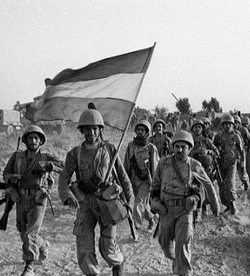Khazi Revolution: Difference between revisions
No edit summary |
|||
| Line 73: | Line 73: | ||
== Origins == | == Origins == | ||
The Khazi Revolution’s causes can be traced back to the immediate founding of the nation in 1946, through the [[Treaty of Ashcombe]], which dissolved the Etrurian Colonial Empire in wake of the [[Solarian War]]. Much like its Badawiyan neighbours, Khazestan was granted independence under the leadership of the most prominent and popular figures, who went on to form monarchies, owing to their prior roles as tribal leaders. Upon its independence, Khazestan came under the rule of Hussein ibn Majid, the leader of the Al-Suwaydi tribe. This form of government was received poorly among most educated Khazis who failed to recognise the legitimacy of the Al-Suwaydi tribe as national leaders. | |||
This lack of legitimacy fed into the general failure of the monarchy to develop a fully coherent national identity. Like most post-Solarian War monarchies, there was an aversion to fostering a Badawiyan identity, through fear that doing so would undermine their reigns or limit any possible patriotism with the monarch at the head. As historian Said Khan noted, “the Post-Solarian Zorasani monarchs worked tirelessly to evoke identities of their nations around them and their families, to be Khazi was to be a subject of King Hussein.” Not only did this fail to cement national solidarity or unity, owing to the previously mentioned lack of legitimacy in the eyes of powerful circles, it left open space for the influence of Pardarian [[Pan-Zorasanism]]. The other disadvantage was that until 1946, none of the Post-Solarian states had existed historically, for the region being dominated by successive Pardarian empires and dynasties for over a millennia. Their borders were defined by Etrurian colonial maps, as well as the provincial boundaries of the pre-colonial Gorsanid Empire, denying any nationalism a geographical anchor from which to emerge. | |||
In Khazestan’s case, these weaknesses were crippling for the monarchy. The Al-Suwaydi tribe had poor relations with its neighbours and rivals in Khazestan, while many ordinary Khazis saw the King and his family as over opulent, wealthy and corrupt, even before they assumed power in 1946. Khazestan’s historic role as the “second pillar to Pardaran within its empires” led to an innate and close socio-political and cultural relationship with its larger neighbour. The shared trials and suffering under Etruria also bridged the two states on an emotional level. | |||
=== Economic stagnation === | |||
=== Social injustice === | |||
=== King Hussein === | |||
=== Khazi Revolutionary Resistance Command === | |||
=== Pardarian influence === | |||
== Revolution == | == Revolution == | ||
=== Pardarian invasion=== | === Pardarian invasion=== | ||
Revision as of 22:01, 12 February 2020
| Khazi Revolution Tir Revolution | |||
|---|---|---|---|
| Part of Zorasani unification | |||
 KRRC leader Mustafa al-Kharadji (L) with Ali Sayyad Gharazi following the King's death | |||
| Date | 11 July 1952 - 18 November 1952 (4 months, 7 days) | ||
| Location | |||
| Caused by |
| ||
| Goals | Overthrow of the Abdulkarimite monarchy Unification of Khazestan and Pardaran | ||
| Methods | |||
| Resulted in |
| ||
| Parties to the civil conflict | |||
| Lead figures | |||
| Casualties | |||
| 2,583 protesters and loyalists killed 2,800-4,000 protesters injured | |||
The Khazi Revolution (Badawiyan: ثورة العرفانية; Thawrah al-Kaṣiyyah), also known as the Tir Revolution in Pardaran (Pasdani: انقلاب تیر; Enqelâbe Tir) was a series of events that led to the overthrow of the Abdulkarimite monarchy and the establishment of an interim government led by the Khazi Revolutionary Resistance Command and the unification of Khazestan and Pardaran in December 1952 and the division of the country. The overthrow was aided by a several leftist groups and movements and by a military invasion by neighboring Pardaran.
Opposition to the King escalated with the emergence of the Khazi Revolutionary Resistance Command in 1948 as the most prominent anti-monarchist group. By 1950, the KRRC was receiving significant materiel aid from Pardaran, enabling it expand its bases of operations and its network across Khazestan. In the summer of 1952, food shortages led to bread riots and eventually mass demonstrations against the monarchy, which now began to respond with violent crackdowns. Influenced by the KRRC, the mass protests grew rapdily and spread to every major city in the country, drawing the involvement of numerous leftist groups. Between July and October, the KRRC worked to use its network within the military to under the King's authority, culminating in the Army's declaration of neutrality on November 1. On November 5, in support of the KRRC, Pardaran invaded Khazestan and seized the capital, Faidah on November 10. The following day, the King and most of his family were captured outside the capital and executed. Within hours, the KRRC under Mustafa al-Kharadji proclaimed a provisional government. During this time, significant numbers of royal court members and loyalist army units fled to the north, leading to the proclamation of the Second Kingdom of Khazestan and the country's formal division.
The revolution led to the formation of the Union of Khazestan and Pardaran and is widely considered the first major event of the Arduous Revolution, which would result in a series of major conflicts and political upheveal before directly leading to the unification of Zorasan into the Union of Zorasani Irfanic Republics in 1980. The revolution also proved the viability of Sattarism among Badawiyan anti-monarchist elements, much to the concern of Badawiyan states, who would go on to form the Mubaraz Pact in 1953.
Origins
The Khazi Revolution’s causes can be traced back to the immediate founding of the nation in 1946, through the Treaty of Ashcombe, which dissolved the Etrurian Colonial Empire in wake of the Solarian War. Much like its Badawiyan neighbours, Khazestan was granted independence under the leadership of the most prominent and popular figures, who went on to form monarchies, owing to their prior roles as tribal leaders. Upon its independence, Khazestan came under the rule of Hussein ibn Majid, the leader of the Al-Suwaydi tribe. This form of government was received poorly among most educated Khazis who failed to recognise the legitimacy of the Al-Suwaydi tribe as national leaders.
This lack of legitimacy fed into the general failure of the monarchy to develop a fully coherent national identity. Like most post-Solarian War monarchies, there was an aversion to fostering a Badawiyan identity, through fear that doing so would undermine their reigns or limit any possible patriotism with the monarch at the head. As historian Said Khan noted, “the Post-Solarian Zorasani monarchs worked tirelessly to evoke identities of their nations around them and their families, to be Khazi was to be a subject of King Hussein.” Not only did this fail to cement national solidarity or unity, owing to the previously mentioned lack of legitimacy in the eyes of powerful circles, it left open space for the influence of Pardarian Pan-Zorasanism. The other disadvantage was that until 1946, none of the Post-Solarian states had existed historically, for the region being dominated by successive Pardarian empires and dynasties for over a millennia. Their borders were defined by Etrurian colonial maps, as well as the provincial boundaries of the pre-colonial Gorsanid Empire, denying any nationalism a geographical anchor from which to emerge.
In Khazestan’s case, these weaknesses were crippling for the monarchy. The Al-Suwaydi tribe had poor relations with its neighbours and rivals in Khazestan, while many ordinary Khazis saw the King and his family as over opulent, wealthy and corrupt, even before they assumed power in 1946. Khazestan’s historic role as the “second pillar to Pardaran within its empires” led to an innate and close socio-political and cultural relationship with its larger neighbour. The shared trials and suffering under Etruria also bridged the two states on an emotional level.
